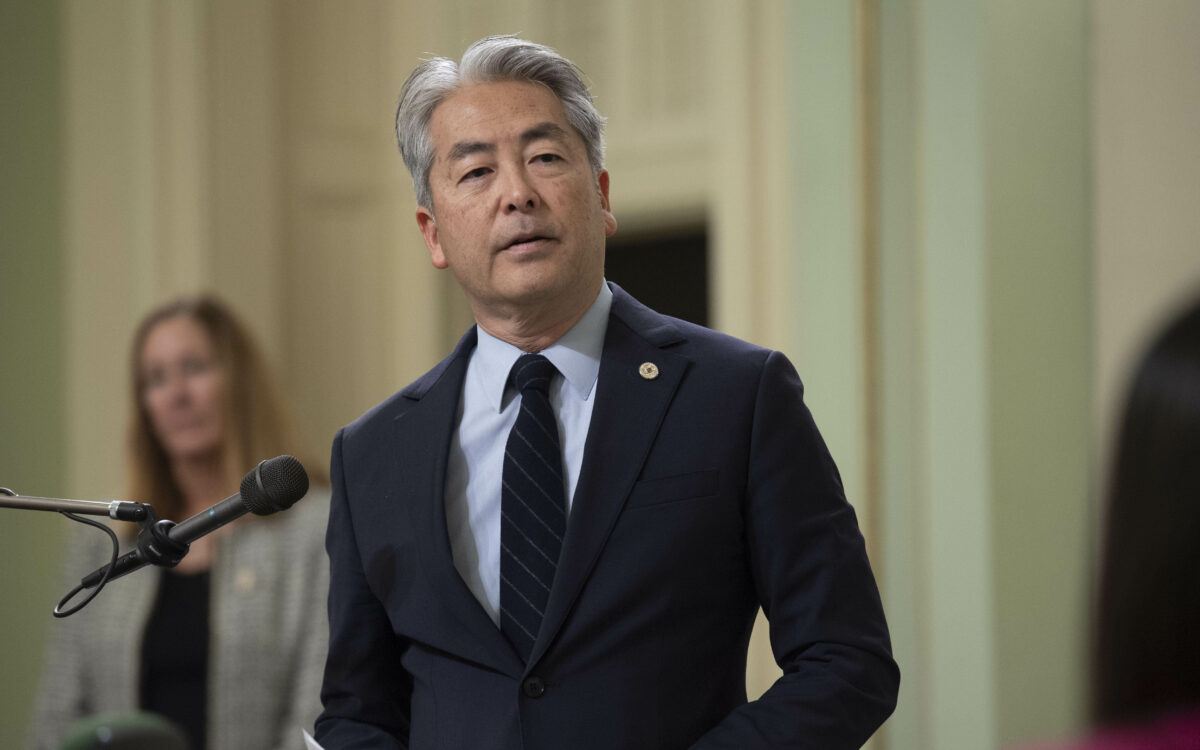Al Muratsuchi, the new chairman of the Assembly Education Committee, is seeking to raise pay statewide for teachers and other school workers by 50% over the next seven years. To pay for it, he’s proposing to increase base funding under the Local Control Funding Formula, also by 50%, in legislation he introduced last week.
The California Federation of Teachers, the smaller of the two unions that represents teachers, is the sole sponsor of the bill. “We went to him (Muratsuchi) with the idea to address the staffing crisis, and he agreed,” said Jeff Freitas, CFT president.
“We’re all aware of the crisis,” said Muratsuchi, a Democrat from Torrance. “Numerous studies have found that young people don’t become teachers because of pay.”
Muratsuchi has authored other bills over the past five years calling for big increases in per student funding to align California with the top 10 funded states. Although they haven’t passed, Gov. Gavin Newsom and lawmakers have capitalized on rising state revenues to approve record increases to the funding formula.
Assembly Bill 938, however, would take a very different tack, by making higher employee pay the explicit driver of multiyear increases in TK-12 funding.
The bill assumes that school districts and charter schools would agree with the explicitly stated purpose of AB 938 and would commit the bulk of their yearly base funding increases to higher pay for employees.
But the bill would state an intention, not impose a mandate. Only future Legislatures can decide how much to spend annually on the funding formula and how to spend it. They could have a different strategy for recruiting teachers, or they may be faced with a recession and suspend a cost-of-living adjustment, or COLA.
The bill also would not dictate the size of annual raises for employees in every district; that would remain subject to local bargaining and school board approval. But AB 938 would give employee unions leverage in their negotiations, as it should, said Freitas. Unions that reached an impasse and turned to a fact finder could refer to the Legislature’s intent to justify a larger raise, for example.
“If districts ignore what is provided by the state for employees, what is left is to go out on strike,” he said. “We’ll be working with our unions to move forward together.”
Claudia Briggs, a spokesperson for the California Teachers Association, which supports the bill, said, “We would hope that districts would act in the best interest of students and follow the intent of the law.”
Along with the CFT and CTA, Muratsuchi can expect unions serving classified workers, like the Service Employees International Union, will be four-square behind AB 938.
Following a three-day strike last month, SEIU 99, representing hourly employees in Los Angeles Unified, ratified a contract giving members a phased-in 30% pay increase — already more than half-way toward the 50% target raise under the bill.
A hearing on the bill before the Assembly Education Committee is scheduled for April 26, when the CFT plans to launch its campaign for the bill, with dozens of school employees from across the state rallying at the Capitol and testifying at the hearing.
Some skepticism, concerns
Muratsuchi said the bill underscores the need to address a growing “teacher wage penalty” that discourages young people from going into teaching. The preamble of the bill cites a 2022 study by the Economic Policy Institute that found that the gap between wages of teachers and other professions with similar education and certification requirements has grown to 17.6% in California and 23.5% nationwide in 2021.
Muratsuchi said the strike in Los Angeles Unified highlighted that cafeteria workers were not getting paid a living wage. “The pay wasn’t enough to fill these and other positions,” he said.
However, Muratsuchi may face opposition from school district management organizations, which were not consulted in drafting the bills. The California School Boards Association and the Association of California School Administrators are withholding public comment, for now.
But other observers, while agreeing with the bill’s revenue aspirations, are expressing reservations about its solutions.
“Raising LCFF rates by 50% is admirable, and all education advocates, including me, support this aspirational goal. Achieving this goal, however, is not realistic given plummeting state revenues and consensus economic forecasts,” said Eric Premack, executive director of the Charter Schools Development Center, which provides leadership development, advocacy and technical assistance on charter school issues.

Todd Maddison, director of research for Transparent California, a project that compiles and makes publicly available government pay and pension data in California, questions the Economic Policy Institute’s data. His analysis of 2021-22 compensation determined the median California teacher salary was $96,323 – $8,000 more than a comparably educated worker outside of education.
Added Premack, ”When combined with a very strong retirement system, the typical substantial health and welfare benefits, and typical work year of 185 days, and unparalleled job security, this is very sound compensation.”
Employee compensation consumes 85% to 90% of all district expenditures; the remaining 10-15% must absorb rising costs of employee pension obligations and health-care contributions, putting a squeeze on other initiatives to raise student achievement.
The bill would encroach on school boards’ discretion under local control, said Mike Fine, CEO of the Fiscal Crisis and Management Assistance Team, or FCMAT, a school finance agency charged with helping school districts in financial trouble. Restricting the Local Control Funding Formula’s unrestricted funding is at odds with the law’s principles, he said. ‘At some point the “L” won’t be ‘local’ but ‘legislative’.”
Fine, too, credits Muratsuchi pointing out the need for addressing compensation.
“Without adequate year-over-year increases that align with inflation, the purchasing power of school employees declines,” as the Economic Policy Institute report indicates, he said.
But some districts have lower compensation levels to offset lower class sizes or other classroom supports, Fine said. “The value of local collective bargaining is that it considers local conditions based on the welfare of the students and community. Why should their local decision be penalized?”
Premack said awarding the same across-the-board increases for all teachers is an inefficient approach. “It’s an extremely expensive way to address teacher shortage/retention issues, especially when we know that the shortage is most problematic in specific areas,” he said, such as math, science and special education.
The funding formula’s base funding, making up 82% of the total, covers districts’ basic expenditures, from textbooks to electricity to employee compensation. The remaining 18% is dedicated to raising student achievement of underserved students and is distributed through “supplemental” and “concentration” grants to districts based on the numbers of English learners and low-income, homeless and foster students who attend.
All districts receive the same base funding per student. The funding varies by grade span, recognizing that it costs more to educate high school students than elementary and middle school students. AB 938 would set new funding targets for grade spans for 2030-31, from $13,749 per student for kindergarten through third grade to $16,653 per student grades 9 to 12. That is 50% more than the $9,166 to $11,102 respectively that districts are receiving this year for those grades.
Using the state’s latest projections for annual cost-of-living adjustments for the next four years and smaller COLA estimates for the remaining years, assuming inflation will be tamed by then, the school consultancy firm School Services of California estimates that COLAs will cover most, but not the full 50% pay raise in the bill. The state would have to meet the 11% estimated shortfall by funding a “super COLA” over the next seven years or raise more revenue for education — an option the bill does not cover.
In his January budget proposal, Newsom included an 8% COLA for 2023-24, but projections will undoubtedly change with economic conditions, and calculating how much they are contributing annually to meet the 50% raises will likely be complex.
The bill calls for using the teacher salary schedules that FCMAT and unions annually collect for the state, called the Form J-90. Filing is currently voluntary, with about 80% of districts enrolling 95.6% of students participating; it would become mandatory, starting in 2023-24. But districts have not reported salaries for classified workers, and unlike certificated employees, who have several salary schedules, classified bargaining units usually have 40 to 50 salary schedules tied to various jobs, from bus drivers to classroom aides, Fine said, so the structure of the reporting and the volume of data will be complicated and increase significantly.
“There needs to be a thoughtful discussion about the proposal to identify the opportunities and challenges it presents,” Fine said.
